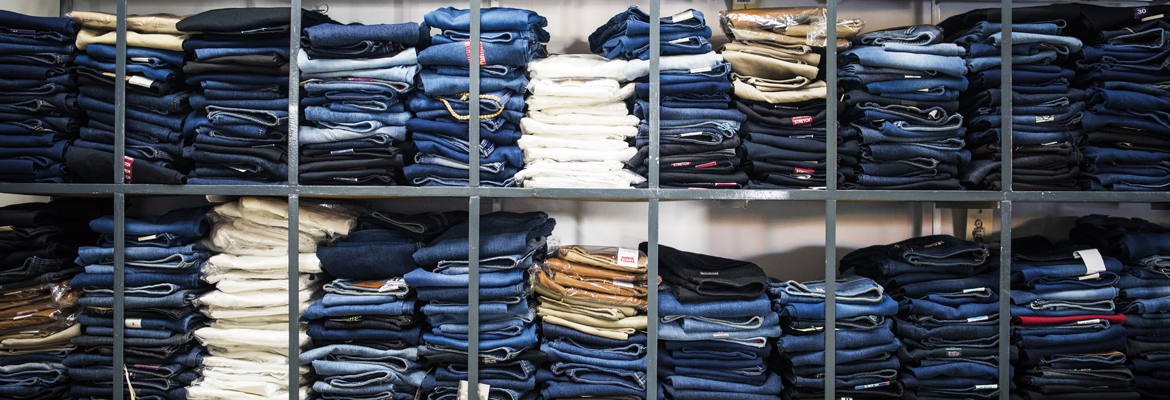In Tehuacán there are over one hundred industrial laundries, some legal and others illegal. For over thirty years the city, in the region of Puebla, has been a cornerstone of the textile industry. Mexico in general, is second only to China in the sector. Once famous for the purity of its water, today Tehuacán is better known for the colour of its water. Blue. Or rather “blue jeans.” They call it “aguas azules.” Streams and irrigation canals, at certain times of day, are tainted blue. This is when the industrial washing machines finish their cycles and drain the residues of the sandblasting process into the drainage. Nowadays that’s how jeans are fashionable: worn down or “distressed.”
Due to the contaminated water, peasants of entire towns have been ordered to stop growing vegetables and cultivating orchards. The only crop that can be grown is corn. The repercussions on transgressors are hefty fines, especially if, often out of a need for revenue, they then go on to sell their produce in city markets. Some even claim to have been threatened with incarceration.
Notwithstanding the fact that Greenpeace has launched multiple campaigns: in 2011 one called “Detox my Fashion,” in an attempt to teach the world of fashion about environmental issues; as well as in 2012 publishing the report Hilos Toxicos, focusing on the contamination of rivers on behalf of the Mexican textile industry, in Tehuacán nothing has changed. The industrial laundries connected to the large brands, first among them Levi’s, continue to flush waste water into canals and are yet to install water purifiers.
On top of the environmental repercussions, workers are also suffering the consequences. Before being washed, the trousers are treated with chemical agents. Lucia Ortega Rodriguéz, who has worked for 35 years in a company that even boasts a “social responsibility” certificate, is sick. In 2015 she was diagnosed with interstitial pneumonia, a chronic lung disease. For this reason, the company should provide her with a respiratory mask. “However – she reveals – the safety norms are only applied in those two or three days a year in which there are checks, for the rest of the time we work without a mask and without gloves.”
The past 9th January, 70,000 people asked Armani and Primark, amongst others, to improve transparency in relation to their productive processes. Their appeal was given a voice through the “Clean Clothes Campaign,” the largest alliance of unions and NGO’s that aims for the improvement of working conditions in the clothing sector. Included in the various campaigns launched by the association, there is one that targets the sandblasting of jeans. However, it appears to have remained unchanged since 2013, whilst the deterioration in wellbeing of the people affected continues, just as is occurring in Tehuacán.
“Detox my fashion”, www.greenpeace.org/archive-international/en/campaigns/detox/fashion
“Campagna Abiti puliti”, www.abitipuliti.org
Photos by Diana Bagnoli
 |
|
The water drainage at one of the laundries in San Lorenzo Teotipilco in the state of Puebla, Mexico.
|
 |
|
A Jeans shop in Tehuacán.
|
 |
|
A close up of the soil beside the Lavasport industrial laundry, one of the large companies that package jeans for third parties and supply some of the big brands.
|
 |
|
A washing machine for jeans in one of the major laundries of San Lorenzo Teotipilco, in the state of Puebla, Mexico.
|
 |
|
A pile of jeans at one of the companies in Tehuacán.
|
 |
|
The daughter of farmers in San Diego Chalma tries to catch a turkey in her courtyard after school. Animals have become their only form of sustenance as crops are considered toxic.
|
|
|
|
A waste water canal in San Diego Chalma, state of Puebla. At a certain time of day the river becomes a white froth and then turns blue. This is when the washing machines end their cycles and discharge the residues, without filters, into the waters of the river Valsequillo.
|
 |
|
One of the clandestine jeans companies in Tehuacán.
|
 |
|
Martin Barrios, environmental activist, observes the chemical blue water drainage of the Lavasport industrial laundry, one of the large companies that pollute the waters of Tehuacán and the surrounding area.
|
 |
|
A blue river in San Diego Chalma, the most affected town that has a population of 3,000 inhabitants.
|
 |
|
Hands dyed blue by a washing machine after her shift.
|
 |
|
Lucia has worked for a large jeans company in Tehuacán for 35 years. For the last two years she has suffered from respiratory problems and has been diagnosed with a chronic lung disease.
|
 |
|
In San Lorenzo Teotipilco, a town bordering Tehuacán, there is the largest concentration of industrial laundries.
|
 |
|
A close up of the soil beside the Lavasport industrial laundry.
|



